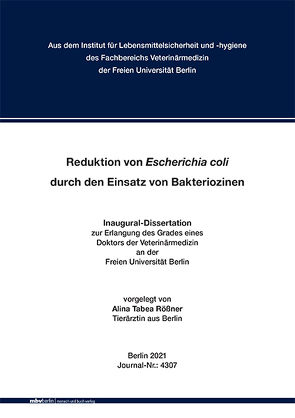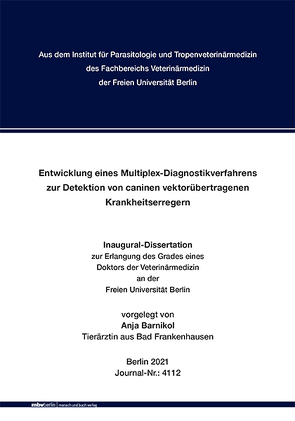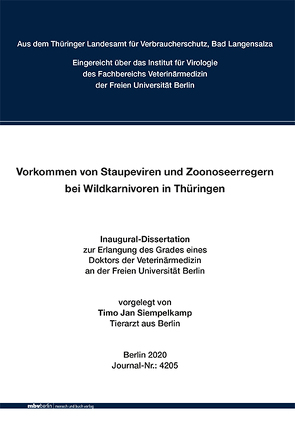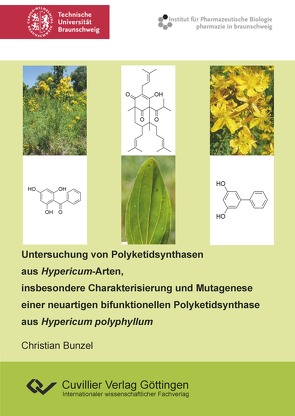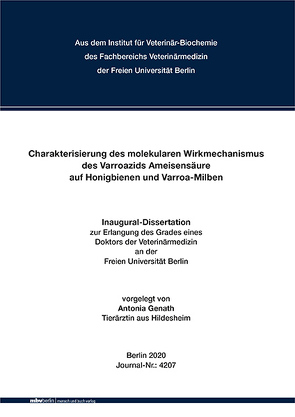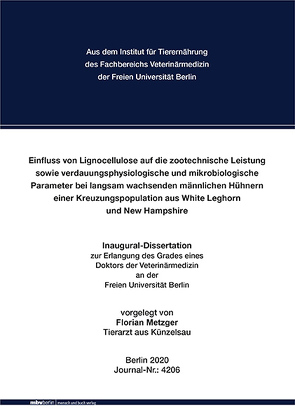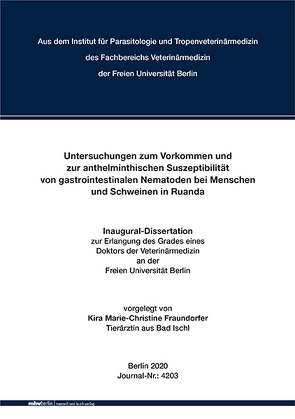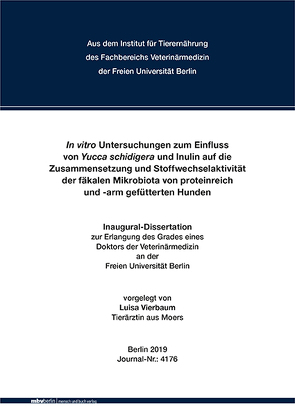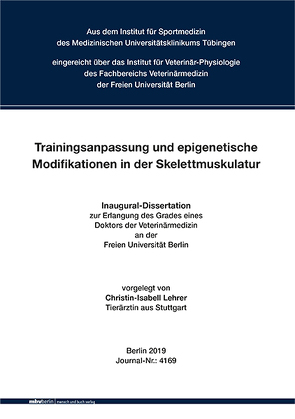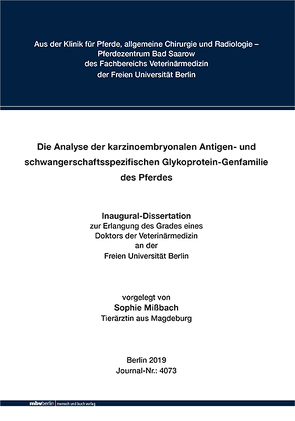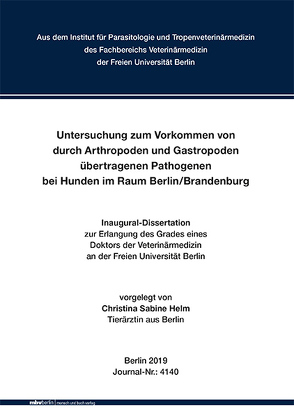Schlüsselwort: polymerase chain reaction
Entwicklung eines Multiplex-Diagnostikverfahrens zur Detektion von caninen vektorübertragenen Krankheitserregern
Prävalenz und Quantifizierung von Arcobacter spp. im Gastrointestinaltrakt von Masthähnchen am Geflügelschlachthof
Vorkommen von CaHV-1 bei Hunden mit Konjunktivitis, Keratitis und normalen Augenbefunden
Vorkommen von Staupeviren und Zoonoseerregern bei Wildkarnivoren in Thüringen
Untersuchung von Polyketidsynthasen aus Hypericum-Arten, insbesondere Charakterisierung und Mutagenese einer neuartigen bifunktionellen Polyketidsynthase aus Hypericum polyphyllum
Charakterisierung des molekularen Wirkmechanismus des Varroazids Ameisensäure auf Honigbienen und Varroa-Milben
Einfluss von Lignocellulose auf die zootechnische Leistung sowie verdauungsphysiologische und mikrobiologische Parameter bei langsam wachsenden männlichen Hühnern einer Kreuzungspopulation aus White Leghorn und New Hampshire
Untersuchungen zum Vorkommen und zur anthelminthischen Suszeptibilität von gastrointestinalen Nematoden bei Menschen und Schweinen in Ruanda
Untersuchungen zum Vorkommen von Salmonella Saintpaul und Campylobacter spp. bei Nutzgeflügelbeständen und weiterführende Untersuchungen der gefundenen Isolate
In vitro Untersuchungen zum Einfluss von Yucca schidigera und Inulin auf die Zusammensetzung und Stoffwechselaktivität der fäkalen Mikrobiota von proteinreich und -arm gefütterten Hunden
Trainingsanpassung und epigenetische Modifikationen in der Skelettmuskulatur
Validierung genetischer Risikovarianten beim familiären Mammakarzinom
Die Analyse der karzinoembryonalen Antigen- und schwangerschaftsspezifischen Glykoprotein-Genfamilie des Pferdes
Untersuchungen zur saisonalen Aktivität der Buntzecke Dermacentor reticulatus im Umland von Berlin und Bestimmung assoziierter Pathogene
Untersuchung zum Vorkommen von durch Arthropoden und Gastropoden übertragenen Pathogenen bei Hunden im Raum Berlin/Brandenburg
Vergleichende epidemiologische und molekularbiologische Untersuchung von Methicillin-resistenten Staphylococcus aureus (MRSA) aus Nutztierhaltungen und deren Umgebung
Der PI3K- Signalweg als therapeutische Zielstruktur von Leiomyosarkomen – Präklinische Validierung mithilfe humaner Xenograftmodelle
Erster Nachweis von Sarcocystis calchasi bei Habichten (Accipiter gentilis) und Sperbern (Accipiter nisus) in Norddeutschland und Beschreibung zweier neuer, nah verwandter Sarcocystis-Arten
Untersuchungen zum Einfluss des Proteingehalts sowie der Proteinqualität im Futter auf die fäkale Mikrobiota von Katzen
Bücher zum Thema polymerase chain reaction
Sie suchen ein Buch über polymerase chain reaction? Bei Buch findr finden Sie eine große Auswahl Bücher zum Thema polymerase chain reaction. Entdecken Sie neue Bücher oder Klassiker für Sie selbst oder zum Verschenken. Buch findr hat zahlreiche Bücher zum Thema polymerase chain reaction im Sortiment. Nehmen Sie sich Zeit zum Stöbern und finden Sie das passende Buch für Ihr Lesevergnügen. Stöbern Sie durch unser Angebot und finden Sie aus unserer großen Auswahl das Buch, das Ihnen zusagt. Bei Buch findr finden Sie Romane, Ratgeber, wissenschaftliche und populärwissenschaftliche Bücher uvm. Bestellen Sie Ihr Buch zum Thema polymerase chain reaction einfach online und lassen Sie es sich bequem nach Hause schicken. Wir wünschen Ihnen schöne und entspannte Lesemomente mit Ihrem Buch.
polymerase chain reaction - Große Auswahl Bücher bei Buch findr
Bei uns finden Sie Bücher beliebter Autoren, Neuerscheinungen, Bestseller genauso wie alte Schätze. Bücher zum Thema polymerase chain reaction, die Ihre Fantasie anregen und Bücher, die Sie weiterbilden und Ihnen wissenschaftliche Fakten vermitteln. Ganz nach Ihrem Geschmack ist das passende Buch für Sie dabei. Finden Sie eine große Auswahl Bücher verschiedenster Genres, Verlage, Autoren bei Buchfindr:
- Polymerase Chain Reaction (PCR)
- Polymerase-Ketten-Reaktion
- POLYMERASE-KETTENREAKTION
- Polymerase-Kettenreaktion (PCR)
- Polymerasekettenreaktion
- Polymeration
Sie haben viele Möglichkeiten bei Buch findr die passenden Bücher für Ihr Lesevergnügen zu entdecken. Nutzen Sie unsere Suchfunktionen, um zu stöbern und für Sie interessante Bücher in den unterschiedlichen Genres und Kategorien zu finden. Unter polymerase chain reaction und weitere Themen und Kategorien finden Sie schnell und einfach eine Auflistung thematisch passender Bücher. Probieren Sie es aus, legen Sie jetzt los! Ihrem Lesevergnügen steht nichts im Wege. Nutzen Sie die Vorteile Ihre Bücher online zu kaufen und bekommen Sie die bestellten Bücher schnell und bequem zugestellt. Nehmen Sie sich die Zeit, online die Bücher Ihrer Wahl anzulesen, Buchempfehlungen und Rezensionen zu studieren, Informationen zu Autoren zu lesen. Viel Spaß beim Lesen wünscht Ihnen das Team von Buchfindr.
